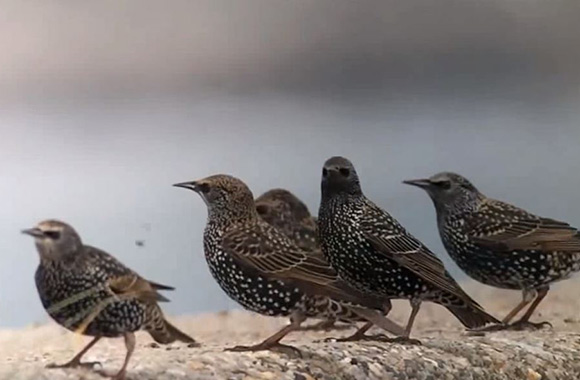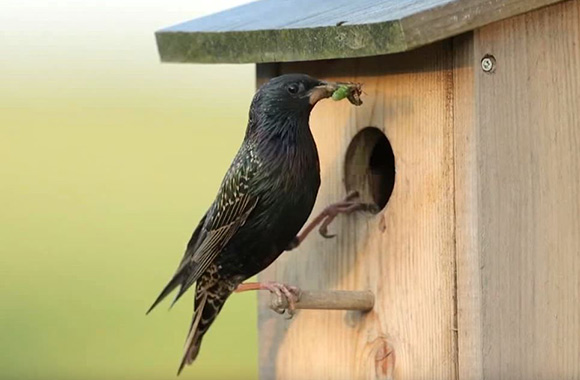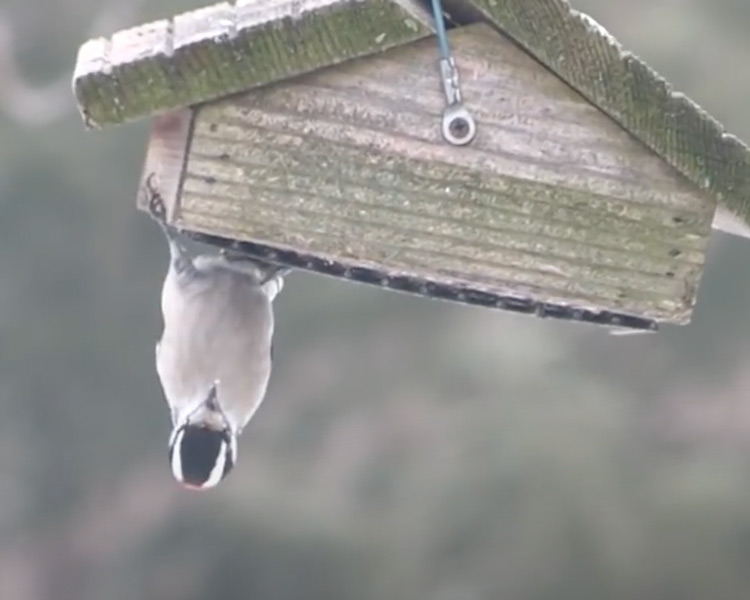Methods for control of Starlings
The European starling is not indigenous the U.S. It was imported to New York City around 1890 but quickly spread into all of the 49 continental states. By 1920 it had become a serious threat in the eastern US because of its decimation of crops and habit of roosting in and on buildings. In the Western U.S. they decimate holly groves, grape vineyards, and orchards. At animal feedlots, they consume considerable amounts of food and contaminate the feed and area with their droppings. Many plans have been initiated to prevent the undesired roosting and feeding of Starlings. In many cases damage is prevented by continuous application of at least one of the control methods mentioned here. The Most effective control measures are ones designed to frighten the birds away from areas without actually harming them.


To make any plan effective, it is important to know your target. Determine the feeding habits of the Starlings. Be Persistence in your actions. .No single method will work 100% for excessive periods of time, so the use of a variety of techniques much more effective. A very successful method is the use of frightening devices. A good old fashioned scarecrow can often do the job. Mylar flags or ribbons hung around the perimeter are also effective. Loud noise such as a radio or the use of firecrackers will send the birds scattering as well. If you are in rural area protecting your fields, firing off a 22 Caliber rifle or Shotgun will do the same.
The .22 caliber rifle is currently one of the means known for frightening blackbirds away from open fields. The Shooter should be in an elevated stand, placing him above the level of the field.
Another device that has proven effective is the Electric Perch. Two wires are suspended above the area at a height of about 14 feet. The wires should be about 2 inches apart. They are attached to a transformer that would run an electric fence. A 15,000 volt transformer will shock the birds without causing permanent damage. Commercially available sonic emitters can be placed throughout your property to run off the birds. These devices come in many styles and prices, but each claim to drive off the birds with ultrasonic pitches.
There are also chemical Repellents available to make the plants undesirable, but these cannot be used on plants intended to be food for livestock or humans. The use of landscape netting is effective cover for plants, trees, and bushes that serve as food. By eliminating access to the food supply the birds are forced to go elsewhere. He same is true about water sources, and nesting areas. Eliminate standing water and excess vines, brush and deadfall around your property and it will be less desirable to the starlings.
A final solution that is not as effective as most is trapping. Starlings are difficult to lure into traps unless food is scarce. Trapping is not a practical means of reducing bird populations around large grain fields, but is fairly effective in smaller areas like backyards, feedlots, and corrals.
A self-operating cage trap seems to be the most effective style for capturing starlings. It operates on a simple principle; birds enter through small funnel shaped holes in the wire center section of the cage top. Once inside, they are unable to escape the way they entered, and there is no other way out. Light Traps are useful in large fields where great amounts of birds are causing problems. This is a trap used at night. It consists of a series of aluminum pipe arches covered in nylon netting.
The arches are higher in the front (up to 35 feet) than in the back (around 10 feet) and it ends in a secure cage. Battery operated lights are set inside the trap. When it is ready “drivers” beat trees and make lots of noise to scare the roosting birds. They instinctively fly towards the light and are trapped. The elevator trap is a very small, portable cage around 2 feet long 1.5 feet wide, and 8inches high. At one end is a weighted “elevator” platform. A bird enters to get the bait and the platform drops into the cage below. As the bird moves off the platform, it rises back into position. This trap has proved most effective in orchards and vineyards. . No matter which trap you choose, once you have gathered your birds, they can be banded and relocated, or eradicated with any number of Ag approved gases available on the market.
Poison as a means of eradication has not been discussed simply because it an ineffective means of controlling starlings, and poses a danger to other animals and the environment. There are no products available that can safely and humanely take out large batches of birds without the possibility of killing other wildlife, pets, or people.

Murmurations of starlings are beautiful to watch, and are majestic in nature. When some of those birds start to flick towards your property, however, you’ll likely come into some trouble. With birds comes bird droppings, dead birds, nests, babies, food stealing, and many more issues besides.
In order to stop starlings from becoming a nuisance on your property, you should consider putting one or more of the following modifications in place. Combining approaches is best.
Remove food sources - You will need to take your bird feeders down for a while. In order to stop starlings causing problems on your property, you’re going to need to stop feeding them — and that means stopping feeding the other birds that you do want to come around. Eventually, you can put the feeders back.
Use starling-appropriate spike strips on windowsills, rooftops, ledges, etc. ~ These, when installed properly and safely, will stop starlings and other birds from landing.
Use starling-appropriate netting in larger spaces such as warehouse roofs, awkward roof ledges, etc. ~ Netting stops birds from being able to access much larger portions of the roof or property, but it is not suitable for all types. If you look a little closer at some city and county buildings, you may see bird netting in action, usually to prevent problematic pigeons.
If you are in any doubt as to how best to sort your nuisance bird problem, get in touch with local wildlife control specialists that deal with birds.

